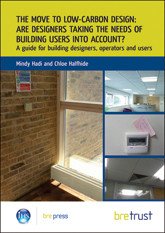Cart (0)

Book
The move to low-carbon design: are designers taking the needs of building users into account?A guide for building designers, operators and usersDownloadable version
Publisher
BRE Electronic Publications
Author
Mindy Hadi and Chloe Halfhide
Format
A4, 28pp
Subject / Keyword
FB21
Published Date
04-Jan-2010
ISBN
9781848061163
Many new buildings are designed to be as energy efficient as possible and use innovative technical systems for heating, cooling and lighting. But often these buildings do not meet their energy targets because the users of the building do not know how to use the systems, and behave in ways that actually increase energy use above that expected. This guide focuses on eight case studies of schools, offices and other new buildings in which the occupants' behaviour and its potential impact on energy efficiency were assessed. Numerous examples of design faults - for example, poorly labelled light switches, badly located temperature sensors, over-sensitive infra-red controls on sanitary fittings - were identified. Key recommendations are made for designers, facilities managers and building users, supported by detailed checklists on designing, managing and operating lighting, ventilation, temperature and water systems in order to ensure that buildings operate as efficiently as possible. Contents 1 Introduction 2 Case studies - Industrial unit and warehouse - Health care building - Energy-efficient office 1 - Energy-efficient office 2 - Children's Centre - Retail unit - School - Leisure centre 3 Findings - Lighting (Automatic lighting with presence detection but no daylight detection. Glare. Blinds down, lights on. Poorly labelled light switches) - Temperature (Poor location or lack of temperature sensors. Lack of occupant control. Slow responsiveness of heating controls) - Ventilation (Lack of occupant-controlled opening windows. Draughts. Fire doors propped open) - Water (Over-sensitive infra-red controls. Lack of information about the operation of water-efficient sanitary fittings) 4 Conclusion References Appendix: Key recommendations checklist for designers, facilities managers, building users 28 pages. Other publications that may be of interest
Smart home systems and the Code for Sustainable Homes
Complying with the Code for Sustainable Homes Lessons learnt on the BRE Innovation Park
Smart home systems and the Code for Sustainable Homes
Complying with the Code for Sustainable Homes Lessons learnt on the BRE Innovation Park
Book
The move to low-carbon design: are designers taking the needs of building users into account?A guide for building designers, operators and usersDownloadable version
List Price £ 25.00
